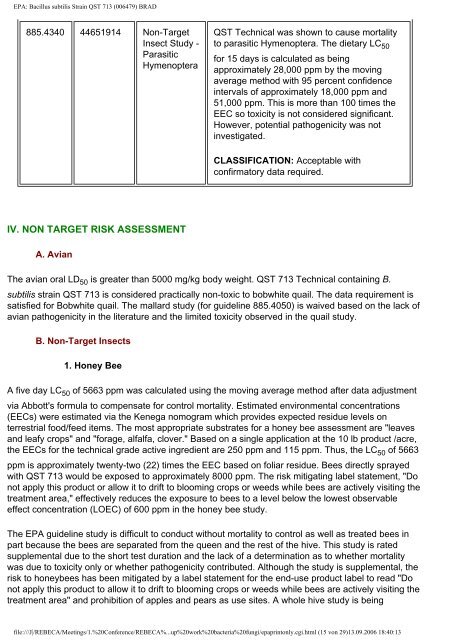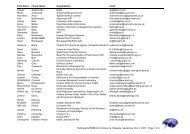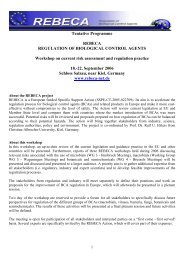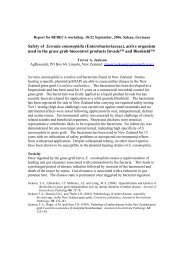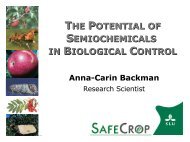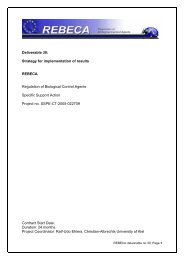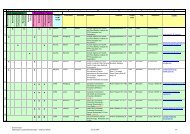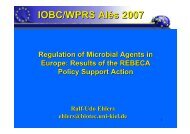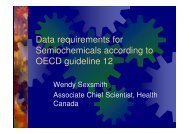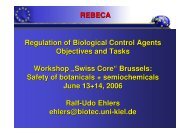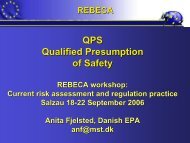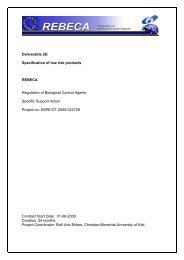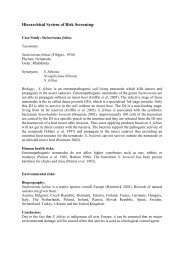EPA: Bacillus subtilis Strain QST 713 (006479) BRAD - REBECA
EPA: Bacillus subtilis Strain QST 713 (006479) BRAD - REBECA
EPA: Bacillus subtilis Strain QST 713 (006479) BRAD - REBECA
- No tags were found...
You also want an ePaper? Increase the reach of your titles
YUMPU automatically turns print PDFs into web optimized ePapers that Google loves.
<strong>EPA</strong>: <strong>Bacillus</strong> <strong>subtilis</strong> <strong>Strain</strong> <strong>QST</strong> <strong>713</strong> (<strong>006479</strong>) <strong>BRAD</strong>885.4340 44651914 Non-TargetInsect Study -ParasiticHymenoptera<strong>QST</strong> Technical was shown to cause mortalityto parasitic Hymenoptera. The dietary LC 50for 15 days is calculated as beingapproximately 28,000 ppm by the movingaverage method with 95 percent confidenceintervals of approximately 18,000 ppm and51,000 ppm. This is more than 100 times theEEC so toxicity is not considered significant.However, potential pathogenicity was notinvestigated.CLASSIFICATION: Acceptable withconfirmatory data required.IV. NON TARGET RISK ASSESSMENTA. AvianThe avian oral LD 50 is greater than 5000 mg/kg body weight. <strong>QST</strong> <strong>713</strong> Technical containing B.<strong>subtilis</strong> strain <strong>QST</strong> <strong>713</strong> is considered practically non-toxic to bobwhite quail. The data requirement issatisfied for Bobwhite quail. The mallard study (for guideline 885.4050) is waived based on the lack ofavian pathogenicity in the literature and the limited toxicity observed in the quail study.B. Non-Target Insects1. Honey BeeA five day LC 50 of 5663 ppm was calculated using the moving average method after data adjustmentvia Abbott's formula to compensate for control mortality. Estimated environmental concentrations(EECs) were estimated via the Kenega nomogram which provides expected residue levels onterrestrial food/feed items. The most appropriate substrates for a honey bee assessment are "leavesand leafy crops" and "forage, alfalfa, clover." Based on a single application at the 10 lb product /acre,the EECs for the technical grade active ingredient are 250 ppm and 115 ppm. Thus, the LC 50 of 5663ppm is approximately twenty-two (22) times the EEC based on foliar residue. Bees directly sprayedwith <strong>QST</strong> <strong>713</strong> would be exposed to approximately 8000 ppm. The risk mitigating label statement, "Donot apply this product or allow it to drift to blooming crops or weeds while bees are actively visiting thetreatment area," effectively reduces the exposure to bees to a level below the lowest observableeffect concentration (LOEC) of 600 ppm in the honey bee study.The <strong>EPA</strong> guideline study is difficult to conduct without mortality to control as well as treated bees inpart because the bees are separated from the queen and the rest of the hive. This study is ratedsupplemental due to the short test duration and the lack of a determination as to whether mortalitywas due to toxicity only or whether pathogenicity contributed. Although the study is supplemental, therisk to honeybees has been mitigated by a label statement for the end-use product label to read "Donot apply this product to allow it to drift to blooming crops or weeds while bees are actively visiting thetreatment area" and prohibition of apples and pears as use sites. A whole hive study is beingfile:///J|/<strong>REBECA</strong>/Meetings/1.%20Conference/<strong>REBECA</strong>%...up%20work%20bacteria%20fungi/epaprintonly.cgi.html (15 von 29)13.09.2006 18:40:13


